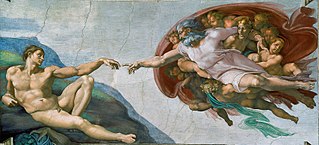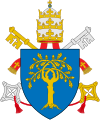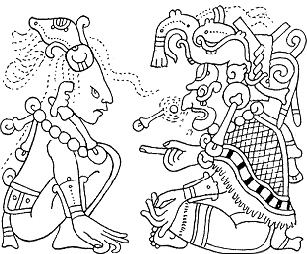
Maya mythology is part of Mesoamerican mythology and comprises all of the Maya tales in which personified forces of nature, deities, and the heroes interacting with these play the main roles. The myths of the Pre-Hispanic era have to be reconstructed from iconography. Other parts of Maya oral tradition are not considered here.
Mayari is a deity of the moon in at least three ethnic peoples in the Philippines.

The Creation of Adam is a fresco painting by Italian artist Michelangelo, which forms part of the Sistine Chapel's ceiling, painted c. 1508–1512. It illustrates the Biblical creation narrative from the Book of Genesis in which God gives life to Adam, the first man. The fresco is part of a complex iconographic scheme and is chronologically the fourth in the series of panels depicting episodes from Genesis.
The term Five Suns in the context of creation myths, describes the doctrine of the Aztec and other Nahua peoples in which the present world was preceded by four other cycles of creation and destruction. It is primarily derived from the mythological, cosmological and eschatological beliefs and traditions of earlier cultures from central Mexico and the Mesoamerican region in general. The Late Postclassic Aztec society inherited many traditions concerning Mesoamerican creation accounts, while however modifying some aspects and supplying novel interpretations of their own.

The Sistine Chapel ceiling, painted by Michelangelo between 1508 and 1512, is a cornerstone work of High Renaissance art. The ceiling is that of the Sistine Chapel, the large papal chapel built within the Vatican between 1477 and 1480 by Pope Sixtus IV, for whom the chapel is named. It was painted at the commission of Pope Julius II. The chapel is the location for papal conclaves and many other important services.

The Chigi Chapel or Chapel of the Madonna of Loreto is the second chapel on the left-hand side of the nave in the Basilica of Santa Maria del Popolo in Rome. It is the only religious building of Raphael which has been preserved in its near original form. The chapel is a treasure trove of Italian Renaissance and Baroque art and is ranked among the most important monuments in the basilica.

Cueva de las Manos is a cave or a series of caves located in the province of Santa Cruz, Argentina, 163 km (101 mi) south of the town of Perito Moreno. It is famous for the paintings of hands. The art in the cave dates from 13,000 to 9,000 years ago. Several waves of people occupied the cave, and early artwork has been carbon-dated to ca. 9300 BP. The age of the paintings was calculated from the remains of bone-made pipes used for spraying the paint on the wall of the cave to create silhouettes of hands.
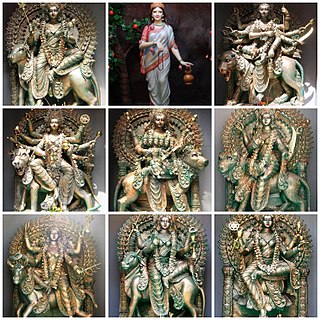
Navadurga, are nine manifestations of the goddess Durga in Hinduism, especially worshipped during the festival of Navratri where each of the nine manifested forms are venerated respectively for each night. The nine forms of Goddess Durga or (Parvati) are: Shailaputri, Brahmacharini, Chandraghanta, Kushmanda, Skandamata, Katyayani, Kaalratri, Mahagauri and Siddhidhatri.

The Loves of the Gods is a monumental fresco cycle, completed by the Bolognese artist Annibale Carracci and his studio, in the Farnese Gallery which is located in the west wing of the Palazzo Farnese, now the French Embassy, in Rome. The frescoes were greatly admired at the time, and were later considered to reflect a significant change in painting style away from sixteenth century Mannerism in anticipation of the development of Baroque and Classicism in Rome during the seventeenth century.

Tauroctony is a modern name given to the central cult reliefs of the Roman Mithraic Mysteries. The imagery depicts Mithras killing a bull, hence the name tauroctony after the Greek word tauroktonos. It is distinct from the cultic slaughter of a bull in ancient Rome and known as a Taurobolium, which was mainly associated with the cult of Cybele.

The Mattancherry Palace is a Portuguese palace popularly known as the Dutch Palace, in Mattancherry, Kochi, in the Indian state of Kerala which features Kerala murals depicting portraits and exhibits of the Rajas of Kochi. The palace was included in the "tentative list" of UNESCO World Heritage Site.

The House of the Vettii is a domus located in the Roman town, Pompeii, which was preserved by the eruption of Vesuvius in 79 AD. The house is named for its owners, two successful freedmen: Aulus Vettius Conviva, an Augustalis, and Aulus Vettius Restitutus. Its careful excavation has preserved almost all of the wall frescos, which were completed following the earthquake of 62 AD, in the manner art historians term the Pompeiian Fourth Style. The House of Vetti is located in region VI, near the Vesuvian Gate, bordered by the Vicolo di Mercurio and the Vicolo dei Vettii. The house is one of the largest domus in Pompeii, spanning the entire southern section of block 15. The plan is fashioned in a typical Roman domus with the exception of a tablinum, which is not included. There are twelve mythological scenes across four triclinium and one cubiculum.

The Sistine Chapel ceiling, painted by Michelangelo between 1508 and 1512, is one of the most renowned artworks of the High Renaissance. Central to the ceiling decoration are nine scenes from the Book of Genesis of which The Creation of Adam is the best known, the hands of God and Adam being reproduced in countless imitations. The complex design includes several sets of individual figures, both clothed and nude, which allowed Michelangelo to fully demonstrate his skill in creating a huge variety of poses for the human figure, and have provided an enormously influential pattern book of models for other artists ever since.

The Book of the Earth is an Ancient Egyptian funerary text that has been called many names such as The Creation of the Sun Disk and the Book of Aker. The Book primarily appears on the tombs of Merneptah, Twosret, Ramesses III, Ramesses VI, and Ramesses VII and serves as a counterpart to the Book of Caverns.

Paradise and Hell is the left and right panels of a minor diptych by a follower of Hieronymus Bosch based on The Haywain Triptych. The image is oil on panel and is 135 x 45 cm. It was painted c. 1510 and is now in the Museo del Prado, Madrid. Paradise is depicted darker than in the Haywain, which possibly represents the darkness of original sin.
Koyash is the god of sun in Turkish mythology.
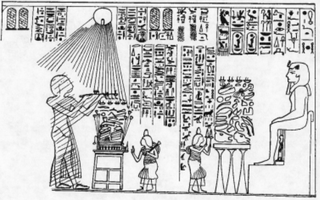
Bek or Bak was the first chief royal sculptor during the reign of Pharaoh Akhenaten. His father Men held the same position under Akhenaten's father Amenhotep III; his mother Roi was a woman from Heliopolis.
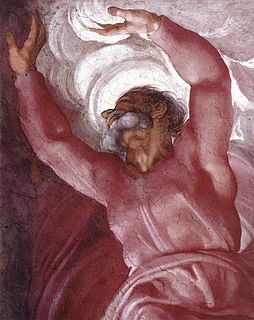
The Separation of Light from Darkness is, from the perspective of the Genesis chronology, the first of nine central panels that run along the center of Michelangelo's Sistine Chapel ceiling and which depict scenes from the Book of Genesis. Michelangelo probably completed this panel in the summer of 1512, the last year of the Sistine ceiling project. It is one of five smaller scenes that alternate with four larger scenes that run along the center of the Sistine ceiling. The Separation of Light from Darkness is based on verses 3–5 from the first chapter of the Book of Genesis:

The Tapestry of Creation or Girona Tapestry is a Romanesque panel of needlework from the 11th century, housed in the Museum of the Cathedral of Girona, Catalonia, Spain. Measuring 3.65 x 4.70 m, it originally may have served as baldachin for the Altar of the Holy Cross in the church's entrance. Some believe that it was used as a curtain or even a carpet. It depicts a series of theological scenes related with the Christian creation myths.

The Bladelin Altarpiece, or Middelburg Altarpiece, is a triptych painting created around 1450 by the Flemish painter Rogier van der Weyden, towards the end of his artistic career. The work depicts scenes relating to the birth of Jesus; it is the only nativity scene definitively attributed to van der Wayden, and so is also known as the Nativity Triptych. It was donated to the new church of the town of Middelburg in 1460, possibly by Pieter Bladelin, who founded the town. It has been in the Gemäldegalerie, Berlin, since 1834.

